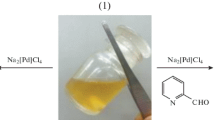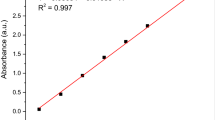Abstract
Homogeneous chitosan/poly(methacrylic acid) solution containing Pd2+ cations was successfully prepared by addition of pyridine-2-carboxaldehyde. Then, this homogeneous solution was smoothly electrospun into uniform composite nanofibers with mean diameter of 442 ± 163 nm, followed by annealing at elevated temperature to improve the solvent resistance. Scanning electron microscopy (SEM) analysis shows that the solvent resistance of the composite nanofibers was improved with the increment of annealing temperature. FT-IR spectra demonstrate that the chemical structure of the composite nanofibers was not oxidized after annealing process. Moreover, the palladium species were homogeneously incorporated inside the composite nanofibers. The catalytic performance of these novel composite nanofibers was evaluated by Heck reaction. The catalysis result shows that these composite nanofibers were very efficient to catalyze the Heck reaction of aromatic iodides with acrylates with yields over 86%. Moreover, these composite nanofibers can be reused for 10 times with little decrement of yield.
Graphic abstract
A novel palladium embedded chitosan composite nanofiber mat has been prepared by electrospinning and thermal techniques. This novel fiber palladium catalyst exhibited high catalytic activity and stability for Heck reaction.









Similar content being viewed by others
References
Chinchilla R and Nájera C 2014 Chemicals from alkynes with palladium catalysts Chem. Rev. 114 1783
Glasnow T N, Findenig S and Kappe C O 2009 Heterogeneous versus homogeneous palladium catalysts for ligandless Mizoroki–Heck reactions: A comparison of batch/microwave and continuous-flow processing Chem. Euro. J. 15 1001
Fortman G C and Nolan S T 2011 N-Heterocyclic carbene (NHC) ligands and palladium in homogeneous cross-coupling catalysis: a perfect union Chem. Soc. Rev. 40 5151
Kielhorn J, Melber C, Keller D and Mangelsdorf I 2002 Palladium—A review of exposure and effects to human health Int. J. Hyg. Envir. Heal. 205 417
Alessandro D Z and Daniele Z 2017 Metallic palladium, PdO, and palladium supported on metal oxides for the Suzuki–Miyaura cross-coupling reaction: a unified view of the process of formation of the catalytically active species in solution Catal. Sci. Technol. 7 3934
Mak S Y, Liew K H, Chua C C, Yarmo M A, Yahaya B H, Samad W Z, Jamil M S M and Yusop R M 2019 Palladium nanoparticles supported on fluorine-doped tin oxide as an efficient heterogeneous catalyst for Suzuki coupling and 4-nitrophenol reduction J. Chem. Soc. 131 111
Wang C A, Nie K, Song G D, Li Y W and Han Y F 2019 Phenanthroline-based microporous organic polymer as a platform for an immobilized palladium catalyst for organic transformations RSC Adv. 9 8239
Dey S K, Dietrich D, Wegner S, Gil-Hernández B and Janiak C 2018 Palladium nanoparticle-immobilized porous polyurethane material for quick and efficient heterogeneous catalysis of Suzuki-Miyaura cross-coupling reaction at room temperature ChemistrySelect 3 1365
Wang Z, Xu M, Shao L and Qi C 2016 Immobilization of palladium on glutaraldehyde chemical modified chitosan fiber mat and its catalytic performance Kinet. Catal. 57 354
Sarvestani M and Azadi R 2017 Palladium nanoparticles deposited on a graphene–benzimidazole support as an efficient and recyclable catalyst for aqueous-phase Suzuki-Miyaura coupling reaction Appl. Organomet. Chem. 31 e3667
Jahanshahi R and Akhlaghinia B 2017 Thiophene methanimine–palladium Schiff base complex anchored on magnetic nanoparticles: a novel, highly efficient and recoverable nanocatalyst for cross-coupling reactions in mild and aqueous media Catal. Lett. 147 2640
Hariprasad E and Radhakrishnan T P 2012 Palladium nanoparticle-embedded polymer thin film “dip catalyst” for Suzuki–Miyaura reaction ACS Catal. 2 1179
Beletskaya I P, Kashin A N, Khotina I A and Khokhlov A R 2008 Efficient and recyclable catalyst of palladium nanoparticles stabilized by polymer micelles soluble in water for suzuki-miyaura reaction, ostwald ripening process with palladium nanoparticles Synlett 2008 1547
Zhong S 2017 Palladium nanoparticles entrapped in melamine-formaldehyde resin microparticles for Mizoroki-Heck reactions Turkish J. Chem. 41 773
Shao L, Ren Y, Wang Z, Qi C and Lin Y 2015 Developing chitosan-based composite nanofibers for supporting metal catalysts Polymer 75 168
Baran T, Baran N Y and Menteş A 2018 Preparation, structural characterization, and catalytic performance of Pd(II) and Pt(II) complexes derived from cellulose Schiff base J. Mol. Struct. 1160 154
Verma S, Jean L B, Jain S L and Muzart J 2013 Nanocrystalline starch grafted palladium(II) complex for the Mizoroki–Heck reaction Dalton Trans. 42 14454
Zhang L, Zhao X, Liu X, Li Y and Cui Y 2010 Synthesis of chitosan-based polymer supported-palladium catalysts and their catalytic performances for Heck reaction Acta Polym. Sin. 6 1033
Liang L, Nie L, Jiang M, Bie F, Shao L, Qi C, Zhang X M and Liu X 2018 Palladium immobilized on in situ cross-linked chitosan superfine fibers for catalytic application in an aqueous medium New J. Chem. 42 11023
Sun K and Li Z H 2011 Preparations, properties and applications of chitosan-based nanofibers fabricated by electrospinning Express Polym. Lett. 5 342
Ridolfi D M, Lemes A P, de Oliveira S, Justo G Z and Durán N 2017 Electrospun poly(ethylene oxide)/chitosan nanofibers with cellulose nanocrystals as support for cell culture of 3T3 fibroblasts Cellulose 24 1
Shao L, Xing G and Qi C 2019 Cobalt, copper and nickel-embedded chitosan/paas composite nanofiber mats as efficient heterogeneous catalysts for air oxidation of benzoin to benzil Cellulose 26 1
Amaral I F, Granja P L and Barbosa M A 2005 Chemical modification of chitosan by phosphorylation: an XPS, FT-IR and SEM study J. Biomat. Sci-Polym. E 16 1575
Plank J and Yu B 2010 Preparation of hydrocalumite-based nanocomposites using polycarboxylate comb polymers possessing high grafting density as interlayer spacers Appl. Clay Sci. 47 378
Gasgnier M 2001 IR spectra of some potassium carboxylates J. Mater. Sci. Lett. 20 1259
Zahedi S, Safaei J G and Shahbazialavi H 2018 Preparation of chitosan nanoparticles from shrimp shells and investigation of its catalytic effect in diastereoselective synthesis of dihydropyrroles Ultrason. Sonochem. 40(Pt A) 260
Min B M, Lee S W, Lim J N, You Y, Lee T S, Kang P H and Park W H 2004 Chitin and chitosan nanofibers: electrospinning of chitin and deacetylation of chitin nanofibers Polymer 45 7137
Rao K U, Lakshmidevi J, Appa R M, Srasad P S, Narasimhulu M, Vijitha R, Rao K S V K and Venkateswarlu K 2017 Palladium(II)‐porphyrin complexes as efficient and eco-friendly catalysts for Mizoroki-Heck coupling ChemistrySelect 2 7394
Shao L, Du Y, Zeng M, Li X, Shen W, Zuo S, Lu Y, Zhang X M and Qi C 2010 Ethanol-promoted reductive homocoupling reactions of aryl halides catalyzed by palladium on carbon (Pd/C) Appl. Organomet. Chem. 24 421
Acknowledgements
The authors acknowledge the financial support from Zhejiang province welfare technology applied research project (No. LGG20E030001).
Author information
Authors and Affiliations
Corresponding author
Rights and permissions
About this article
Cite this article
Zhong, S. Preparation of chitosan/poly(methacrylic acid) supported palladium nanofibers as an efficient and stable catalyst for Heck reaction. J Chem Sci 132, 118 (2020). https://doi.org/10.1007/s12039-020-01805-1
Received:
Revised:
Accepted:
Published:
DOI: https://doi.org/10.1007/s12039-020-01805-1




